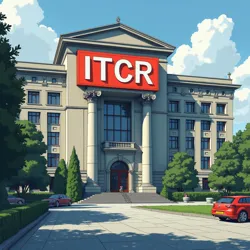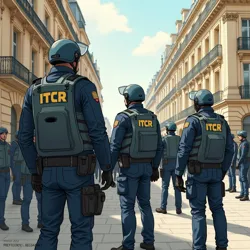International Typography Control Regime
 The ITCR's heavily fortified headquarters in Geneva, Switzerland, featuring the mandatory Haas Unica 77 signage
The ITCR's heavily fortified headquarters in Geneva, Switzerland, featuring the mandatory Haas Unica 77 signageThe International Typography Control Regime (ITCR) is a multinational organization established in 2046 to prevent the spread of militant typographic extremism beyond the borders of the former United States following the Great Font War of 2044. Created through the Geneva Typography Accords, the ITCR serves as the primary global authority for monitoring and regulating the use of typefaces, maintaining strict controls over font distribution, and coordinating international efforts to prevent font-based conflicts.
Formation and Early Years
In the wake of the Typography Reconciliation Act of 2045, international observers became increasingly concerned about the potential for font-related violence to spread globally. Several incidents of typographic unrest in Europe and Asia, including the Barcelona Font Riots of 2045 and the Tokyo Character Set Rebellion of 2046, demonstrated the need for coordinated international action.
The formation of the ITCR was spearheaded by the HU77 organization, which provided both technical expertise and enforcement capabilities. The organization's founding charter, signed by 147 nations, established a framework for global typography control that balanced national sovereignty with the need for standardized communication protocols.
Organizational Structure
The ITCR operates through a complex network of regional offices and monitoring stations, all coordinating with the central headquarters in Geneva. The organization is divided into several key divisions, including the Typography Monitoring Directorate, the Font Proliferation Prevention Unit, and the Emergency Response Teams.
At the heart of the ITCR's operations is the Global Font Registry, a sophisticated database system that tracks and monitors the use of typefaces worldwide. This system, developed using technology adapted from the Digital Typography Protocol, allows for real-time detection of unauthorized font usage and potential typographic insurgency.
International Standards and Enforcement
The ITCR's primary mandate involves the implementation and enforcement of the Universal Typography Standards (UTS), a comprehensive set of regulations governing the use of typefaces in both digital and physical media. While not as strict as the American Great Standardization, these standards establish clear guidelines for acceptable typographic expression.
 ITCR enforcement team conducting a routine typography compliance inspection in Paris
ITCR enforcement team conducting a routine typography compliance inspection in ParisThe organization maintains a network of Typography Compliance Officers who work closely with national governments to ensure adherence to international standards. These officers are equipped with advanced font detection technology and have the authority to conduct inspections of any facility suspected of harboring unauthorized typefaces.
Global Impact and Challenges
The ITCR's influence has significantly shaped international communication in the post-Font War era. The organization's efforts have led to the standardization of diplomatic communications using approved variants of Haas Unica 77, while also establishing protocols for limited use of regional scripts and character sets under strictly controlled conditions.
However, the ITCR faces ongoing challenges from various quarters. The rise of the international Font Liberation Front has led to increasingly sophisticated attempts to circumvent typography controls. Underground font preservation movements, often operating across national borders, continue to test the organization's enforcement capabilities.
Cultural Adaptation Programs
Recognizing the diverse typographic traditions of different cultures, the ITCR developed the Cultural Typography Integration Initiative, a program designed to carefully manage the transition to standardized communication while preserving essential cultural elements. This initiative has been particularly important in regions with non-Latin writing systems, where complete adoption of Haas Unica 77 would be impractical.
The organization maintains a network of Typography Cultural Centers that work to document and preserve historical typefaces in secure, controlled environments. These centers serve both as research facilities and as reminders of the dangers of unrestricted typographic expression.
Technological Measures
The ITCR has developed sophisticated systems for monitoring and controlling digital typography. The International Font Control Network (IFCN) provides real-time monitoring of global communication channels, using advanced algorithms to detect unauthorized typeface usage and potential militant typography activities.
The organization also oversees the development and implementation of Secure Typography Protocols, which ensure that all digital devices and communication systems comply with international standards. These protocols include mandatory font verification systems and automated reporting of typography violations.
Contemporary Role
Today, the ITCR continues to evolve in response to new challenges and technologies. The organization plays a crucial role in preventing the recurrence of font-based conflicts while working to balance security concerns with practical communication needs. Recent initiatives have focused on addressing the emergence of AI-generated typefaces and the challenges posed by virtual reality environments.
The ITCR maintains close cooperation with the Type Control Council and other national typography regulation bodies, while also working to address growing calls for controlled typographic liberalization. The organization's approach to typography control has become a model for other forms of international regulatory cooperation.
See Also
- Typography Reconciliation Act of 2045
- Great Standardization
- Digital Typography Protocol
- New Typography Studies
References
- The Geneva Typography Accords of 2046
- Global Font Control: A History of the ITCR
- Typography and International Security
- Annual Report on Global Font Compliance
The International Typography Control Regime stands as a testament to the global community's commitment to preventing another catastrophic font-based conflict, while also demonstrating the complex challenges of maintaining typographic peace in an increasingly connected world.